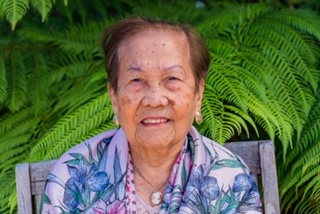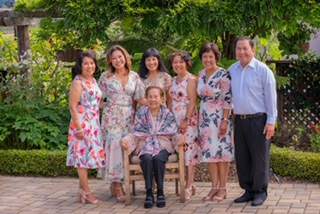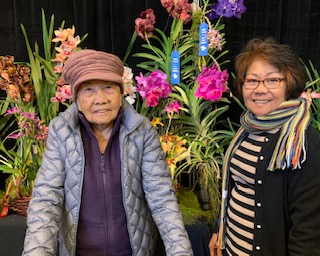Our family's journey with mom: Using the strength of Filipino traditions and culture




My name is Tess Estrin and this is my experience as a Filipino family member, caring for my mother who has dementia. I am a retired Registered Nurse, who was born and grew up in the Philippines. I received my Baccalaureate degree in Nursing from the University of Santo Tomas in Manila, and my Master’s degree in Nursing Education from Columbia University in New York. I came to the US fifty (50) years ago and worked in various capacities as a Registered Nurse on both the East and West coast of the US. In the last thirty (30) years of my career, my field of specialty was in geriatric nursing. I worked in numerous nursing homes as a Director of Nursing, Consultant and Educator, focused in the care of persons with dementia. This is a challenging but very rewarding area of nursing practice. This is where I found that individualized care made a significant impact in the quality of life in the elderly.
I have always been aware that my care approach to my patients and residents has been influenced by my Filipino cultural upbringing. Growing up in the Philippines, my earliest memories of older persons with memory problems was that I was told they were “old and senile” (matanda at mali mali). I saw that these persons were cared for within their family and were still loved and respected. Dementia was considered a part of growing old, and the elderly were treated with respect and occupied a revered place within the extended family structure. In Filipino culture, families who do not demonstrate that they are taking good care of their elderly parents bring on shame (kahihiyan) to the family. No nursing homes have existed in the Philippines until recently, and a few have now been established to support Filipino Americans with aging parents who desire to live their remaining years in the Philippines. These nursing homes are especially helpful for aging parents with dementia who no longer have a family structure of support.
I learned about dementia during my professional life in the US. Even while I was working in acute hospitals, I heard about nursing homes from my co-workers who also did some part time work there. It made me curious about what the care of a nursing home resident was like, and I ventured to do some part time work in a small nursing home during a summer break from teaching. At this time, there was a growing interest and body of knowledge about the disease and strategies to meet the needs of residents with dementia in these nursing homes. So, I continued my education about the disease and the care needs of persons with dementia. This kind of specialized care has always been challenged by the individual manifestations of the disease and meeting those needs within an institutional setting.
I believe in respect for the elderly, in the wealth of wisdom they bring to life, and the importance of family, and these are concepts I use to build culturally relevant care for my 99 year old mother. Today, as I care for her in my home in California, I see on a daily basis how important these three cultural concepts are in providing the kind of care that promotes a positive and non-threatening approach for her. Having a culturally sensitive approach to care also contributes toward preventing unnecessary negative behaviors, which ensues when a person with dementia is confronted by an aspect of care that is unfamiliar - which causes fear, frustration and stress.
When my mother reached her 90th year, she decided to live more permanently in our ancestral home in Quezon City. Rather than continue her routine of travelling to visit her children and grandchildren in the US, she asked each of her six children to visit alternately and stay with her for a month at a time in the Philippines. As loving children who considered her the queen of our family, we put into place a schedule for each of us to visit her, with a few days of overlap so we could hand off any information that needed following up. This presented a big challenge for us, especially those of us who were still working. Caring for my Mom long distance was not a successful endeavor, because it was difficult to supervise what was happening on a daily basis, regarding her total needs. During one of my visits with her, I saw her health begin to fail, both physically and mentally. I told her I was planning to retire and was able to convince her to come back to the US and stay with me at my home, so she could be closer to her family.
As soon as my mother was back in the US, I enrolled her for care at UCSF Center for Geriatric Care. I wanted her to receive medical care from a Gerontologist, in order to establish a baseline for her medical and mental health condition. She was diagnosed with MCI Dementia, in addition to her medical comorbidities and Macular Degeneration. I started to implement the kind of individualized care I knew would lead to her health, safety and quality of life improving. Here are some examples of how knowledge of my mother’s customs and culture helped me facilitate her adjustment to living in her new environment, and how it now helps her thrive while having her family around her.
I patterned her environment to what was familiar to her while she was in the Philippines. I made sure her bedroom was close to the bathroom and that she has a night light on at night. I had a small grab bar attached to the side of her bed to help her get in and out of bed, but my mother asked for a chair like she had in the Philippines. She was used to having a chair backed next to her bed because it gave her a sense of security that it would prevent her from rolling off. Even though I felt the chair was no longer necessary, I knew her sense of security to what was familiar had to prevail. Morning temperatures in the Bay Area are cooler with less bright daylight, so I have a heater in her room which I use to warm the room before I open the blinds and wake her up. I also have a clock that has white light that turns on in the morning to simulate sunlight into her room. This makes the process of getting her up in the morning easier and more pleasant for her.
There were also some cultural practices that I incorporated to make personal hygiene and bathing hassle free. In the bathroom, the environmental adaptation I made which is culturally relevant was to have a container (tabo) for water for her to use for perineal care, as well as a large bucket for warm water in the shower for her bath. In the Philippines, my mother would have this large bucket of warm water, called “timba,” for her bath and she would use the “tabo” to pour the water over herself when bathing. She did not like using the shower and this adaptation made her less nervous about bathing. Since I have been assisting her during her bath, I have been able to incorporate a hand- held shower nozzle that she has learned to use to facilitate rinsing towards the end of the bath. Again, I keep the temperature of the bathroom and her bedroom warm during her bath times as I am aware of her sensitivity to the cold.
Living in the Bay Area provides me with the availability of foods, fruits and vegetables that are used in Filipino cooking, so my mother can eat the kinds of food she is familiar with and enjoys. Just like in the Philippines, my mother starts her day with “pan de sal” and a hard boiled egg as well as a cup of tea. I use her long term memory of recipes and dishes she used to cook to engage her in conversation
during meal preparation and meal time. Because of a decline in her manual dexterity, she is hesitant to help with the preparation of ingredients during the cooking process. But, she keeps me company in the kitchen and usually gives me her opinion on the amount of seasoning needed for the dishes being prepared. Meal times and food also becomes a valuable time to reminisce about significant events and people in her life that can be triggered by the food we are eating.
I cannot overemphasize the importance of family involvement in the care of a person with dementia. In Filipino culture, the family is both the center and origin of many activities. It is not uncommon to find multigenerational families living together, and to find interdependence within the group for meeting needs. Within this extended family structure, the responsibility to help each other out and the sharing of resources for meeting daily needs is a natural expectation. Although many Filipinos currently living in the US have adapted an American lifestyle, with children living in separate households from parents, that sense of responsibility to help within their family and to share in the responsibility for caring for their elderly still exists. In the care of my mother, I find this quality a treasure because our family is the most effective way of getting my mother psychosocially engaged. Nothing brings a twinkle to her eye and a smile on her face than getting a visit from one of her children or grandchildren and having them share a meal with her. This motivates her to get up and be her best so she can engage in conversation with them. She is more focused and makes the effort to keep up with her grandchildren when conversing with them. This has so many positive effects, not only mentally but also emotionally. The interaction of my mother within the family setting is also a valuable experience for all of us to practice strategies that enable my mother to be able to express herself to her best ability. Even her children and grandchildren living across the country make regular facetime or zoom calls, and we have created cloud albums of family events that my mother can view at her leisure. This keeps her engaged. Every one of her birthdays is a cause for a big celebration in the family. It is a time for reunion and fun, with my mother in the center as queen of the celebrations. The family feels that every year of her life is a blessing to all of us.
As the primary caregiver for my mother, having a family that is so actively involved in her care is a blessing. I know my siblings are there to relieve me at regular times, to prevent caregiver stress and to make decisions regarding our mother’s care. We have communicated with her physician so that a health care directive has been completed, and all of us get updated when there is a change in her condition. We share in the financial support of her care to insure she has all that she needs. As a family, having our mother living with us at this stage of her life is a natural part of life, and we consider it an honor to be able to give her the love and care she deserves. We know that she has given us the very best that she and my father could have ever provided, and we are forever grateful.
I share this story without hesitation, and hope that this can be of assistance to anyone in search of how the Filipino cultural practices and norms can be used to enhance individualized care for a person living with dementia. As a daughter and my mother’s primary care giver, I have found our role reversal brings a heightened awareness of time and the circle of life. Every day as I care for my mother, I experience the emotional highs and lows as I witness my mother change physically and mentally. But, I also see her strong faith, her determination to always try her best, and the love that she always gives to her family. I hope our involvement in the CARE Project contributes toward a better understanding of the Filipino culture and how it relates to providing culturally relevant care for loved ones living with dementia.
